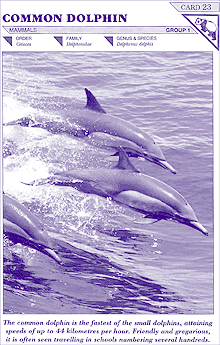| : The Common Dolphin |
|
||||
|
The common dolphin is a friendly animal and lives in the sea around Australia and New Zealand. It is the fastest of the small dolphins and can travel at speeds of up to 44 kilometres an hour. Some sharks and killer whales can travel at speeds of 55 kilometres an hour. The common dolphin is very fun-loving. It can sometimes be seen jumping a long way out of the water and then landing with a big splash. Dolphins live for about 25 years. The female dolphin normally has one baby at a time. This baby is called a calf. The calf is born under water and its mother helps it to the surface for its first breath of air while two "auntie" dolphins keep a look out for sharks. The common dolphin can eat squid, cuttlefish, octopus and shrimp but it usually eats herrings and sardines. The dolphin uses its special language to help it hunt food by sending a series of whistles through the water. It also uses this language to warn other dolphins of dangers such as sharks and killer whales. The killer whale, one of the common dolphin's most feared enemies, is actually a type of dolphin. Sadly, the biggest danger that the dolphin faces now is that it can be trapped in fishing nets and drown. Many dolphins now die this way and these happy animals could become extinct. |
||||
|
Questions / instructions Can you follow these instructions? |
% responses | |||
| y4 | y8 | |||
| 1. Underline the speed that dolphins can travel. | 71 | 91 | ||
| 2.
Put a ring |
76 | 93 | ||
|
3. Put a wriggly line full
answer |
36 |
66 |
||
| 4.
Put a tick |
82 | 96 | ||
|
5. Put crosses appropriate
crosses: (all) 3 |
20 |
51 |
||
|
Commentary Many students at both year 4 and year 8 gave incomplete answers when more than one piece of information should have been identified. |
||||
[ top of the page | Reading and Speaking Report 1996 ]
